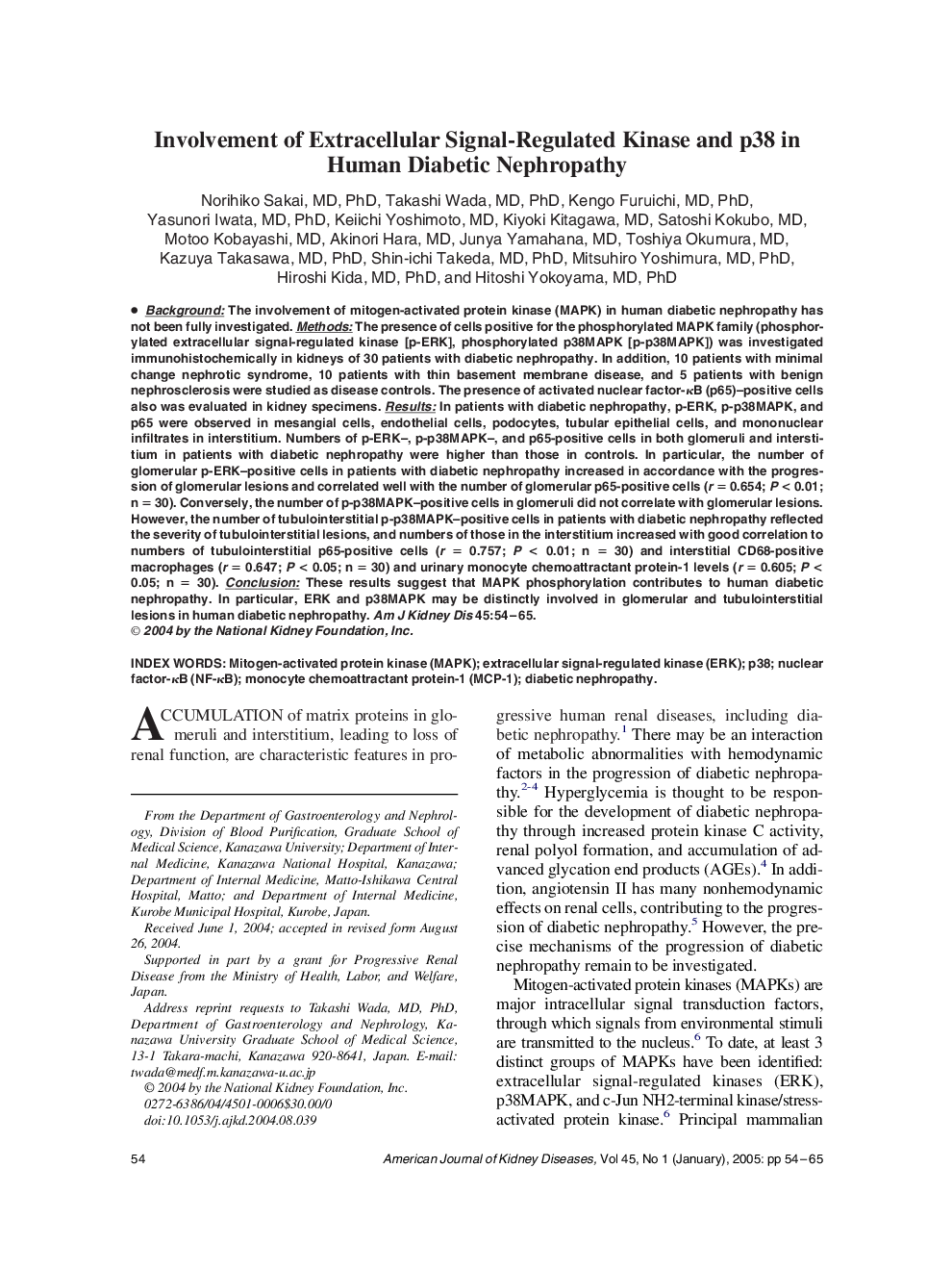| کد مقاله | کد نشریه | سال انتشار | مقاله انگلیسی | نسخه تمام متن |
|---|---|---|---|---|
| 10047776 | 1598410 | 2005 | 12 صفحه PDF | دانلود رایگان |
عنوان انگلیسی مقاله ISI
Involvement of extracellular signal-regulated kinase and p38 in human diabetic nephropathy
دانلود مقاله + سفارش ترجمه
دانلود مقاله ISI انگلیسی
رایگان برای ایرانیان
کلمات کلیدی
p38Nuclear factor-κB (NF-κB) - فاکتور هسته ای κB (NF-κB)Diabetic nephropathy - نفروپاتی دیابتیMonocyte chemoattractant protein-1 (MCP-1) - پروتئین کیمواترافتان مونوسیت 1 (MCP-1)Mitogen-activated protein kinase (MAPK) - پروتئین کیناز فعال Mitogen (MAPK)Extracellular signal-regulated kinase (ERK) - کیناز تنظیم شده سیگنال خارج سلولی (ERK)
موضوعات مرتبط
علوم پزشکی و سلامت
پزشکی و دندانپزشکی
بیماریهای کلیوی
پیش نمایش صفحه اول مقاله

چکیده انگلیسی
Background: The involvement of mitogen-activated protein kinase (MAPK) in human diabetic nephropathy has not been fully investigated. Methods: The presence of cells positive for the phosphorylated MAPK family (phosphorylated extracellular signal-regulated kinase [p-ERK], phosphorylated p38MAPK [p-p38MAPK]) was investigated immunohistochemically in kidneys of 30 patients with diabetic nephropathy. In addition, 10 patients with minimal change nephrotic syndrome, 10 patients with thin basement membrane disease, and 5 patients with benign nephrosclerosis were studied as disease controls. The presence of activated nuclear factor-κB (p65)-positive cells also was evaluated in kidney specimens. Results: In patients with diabetic nephropathy, p-ERK, p-p38MAPK, and p65 were observed in mesangial cells, endothelial cells, podocytes, tubular epithelial cells, and mononuclear infiltrates in interstitium. Numbers of p-ERK-, p-p38MAPK-, and p65-positive cells in both glomeruli and interstitium in patients with diabetic nephropathy were higher than those in controls. In particular, the number of glomerular p-ERK-positive cells in patients with diabetic nephropathy increased in accordance with the progression of glomerular lesions and correlated well with the number of glomerular p65-positive cells (r = 0.654; P < 0.01; n = 30). Conversely, the number of p-p38MAPK-positive cells in glomeruli did not correlate with glomerular lesions. However, the number of tubulointerstitial p-p38MAPK-positive cells in patients with diabetic nephropathy reflected the severity of tubulointerstitial lesions, and numbers of those in the interstitium increased with good correlation to numbers of tubulointerstitial p65-positive cells (r = 0.757; P < 0.01; n = 30) and interstitial CD68-positive macrophages (r = 0.647; P < 0.05; n = 30) and urinary monocyte chemoattractant protein-1 levels (r = 0.605; P < 0.05; n = 30). Conclusion: These results suggest that MAPK phosphorylation contributes to human diabetic nephropathy. In particular, ERK and p38MAPK may be distinctly involved in glomerular and tubulointerstitial lesions in human diabetic nephropathy.
ناشر
Database: Elsevier - ScienceDirect (ساینس دایرکت)
Journal: American Journal of Kidney Diseases - Volume 45, Issue 1, January 2005, Pages 54-65
Journal: American Journal of Kidney Diseases - Volume 45, Issue 1, January 2005, Pages 54-65
نویسندگان
Norihiko MD, PhD, Takashi MD, PhD, Kengo MD, PhD, Yasunori MD, PhD, Keiichi MD, Kiyoki MD, Satoshi MD, Motoo MD, Akinori MD, Junya MD, Toshiya MD, Kazuya MD, PhD, Shin-Ichi MD, PhD, Mitsuhiro MD, PhD, Hiroshi MD, PhD, Hitoshi MD, PhD,